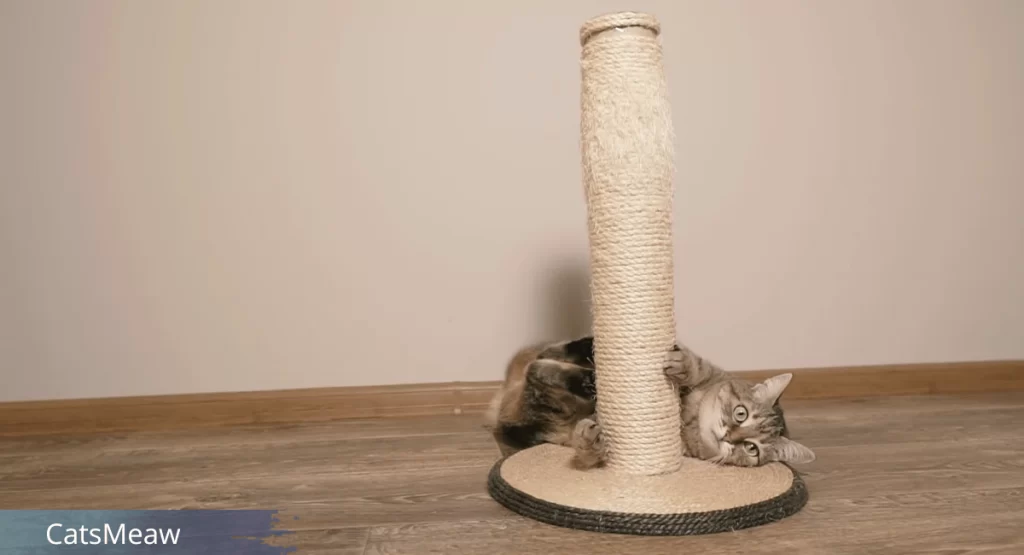Cats scratching furniture frustrates many pet owners. It’s important to remember that cats scratch instinctively. Cats scratch to establish territory, stretch their muscles, and keep their claws. Scratching lets cats communicate with other cats by leaving their smell on their paws. In this article we are going to reveal the best practices to stop cats from scratching furniture.

Table of Contents
Providing Proper Scratching Outlets
Provide scratching outlets to deter your cat from clawing furnishings. A robust, tall sisal rope or cardboard scratching post may alter the game. Cats like to scratch specific furniture, so place the scratching post near it. To satisfy your cat’s tastes, provide various scratching surfaces and textures. Vertical posts or tilted cardboard scratchers may suit particular cats better than horizontal pads.
Training And Positive Reinforcement
Training your cat to utilize scratching posts instead of furniture takes time and commitment. Place snacks or catnip near the scratching post to encourage your cat to use it. When your cat scratches the furniture, gently guide them to the scratching post and praise them. Positive reinforcement like food or praise reinforces desirable behavior.
Avoid punishing or criticizing your cat since this might increase scratching and fear. You may stop cats from scratching furniture and preserve a happy living environment by understanding why cats scratch, giving adequate scratching outlets, and employing positive reinforcement,
Protecting Furniture With Deterrents
Deterrents and scratching outlets may help to stop cats from scratching furniture. Several products are sold to discourage cats from scratching. These items prevent cats from scratching using unpleasant scents or sounds. These deterrents may be applied directly to furniture or used with other training techniques to teach against scratching.
Related: Best Interactive Toys for Indoor Cats
Double-sided tape or sticky pads on furnishings that your cat scratches are another excellent deterrent. Cats avoid scratching sticky paws because they loathe the feeling. Tape and pads lose stickiness with time; therefore, they must be replaced often. Make sure deterrents and furnishings are safe for your cat.
Trimming Your Cat’s Claws
A regular claw trim may also decrease scratching damage as it is one of the best practices to stop cats from scratching furniture. Keep your cat’s claws clipped to reduce furniture damage when scratched. To prevent hurting your cat, claw clipping must be done carefully.
Ask your physician or groomer how to cut your cat’s claws safely. They can show you how and provide ideas to make the procedure stress-free for you and your cat. A scratching post or cushion that naturally wears down your cat’s claws may supplement regular clipping and minimize scratching.
Addressing Underlying Issues
Excessive scratching may indicate stress, worry, or physical difficulties. Investigating underlying issues is essential if your cat keeps scratching despite your attempts. Due to stress and anxiety, cats may scratch more after relocating or getting a new pet.
Cats may scratch excessively for medical reasons, including allergies or skin inflammation. See a vet if you think your cat’s scratching is due to a medical issue or stress. They may discover underlying concerns and propose treatment alternatives to reduce or even to stop cats from scratching furniture and enhance their health.
Environmental Enrichment And Play
Plenty of play and environmental stimulation also reduce your cat’s scratching. Interactive toys like feather wands, laser lights, and puzzles may help your cat stop scratching. Regular playtime gives cats mental and physical activity, vital to their health.

A dynamic environment with lots of vertical space, hiding locations, and perches will fulfill your cat’s instincts and prevent stress-related scratching. Install cat shelves or trees near windows so your cat may safely see the world. Scratching posts or pads in different positions throughout your house might help teach your cat to scratch when climbing and stretching in suitable areas.
Consistency And Patience In Training
Training your cat to quit clawing furniture requires time and consistency. Avoid becoming irritated and giving up on redirecting your cat’s behavior by being consistent. Learning new habits takes time and may include difficulties. Be persistent and reward good conduct with praise.
Maintain your cat’s scratching posts and deterrents consistently. Check and replace worn scratching posts to keep your cat interested. Deterrents should be used, particularly early in training, to teach that scratching furniture is wrong. Through consistent use, your cat will associate scratching posts with positive experiences and gradually stop scratching furniture.
Seeking Professional Assistance
If your cat’s scratching continues or worsens despite your efforts, get expert help. A licensed animal behaviorist or veterinarian with cat behavior expertise may provide advice and services targeted to your cat’s requirements. They can thoroughly assess the behavior to uncover underlying concerns and provide solutions.
If your cat’s clawing is damaging furnishings or endangering their health, professional help may be needed. Medication or behavior modification may be prescribed to address the stress or anxiety causing the behavior. A competent specialist can help you create a thorough strategy to stop cats from scratching furniture and maintain an excellent, harmonious connection with your cat.
Alternative Solutions And Products
There are several alternatives to scratching posts and deterrents to assist your cat stop scratching. Purchase furniture coverings or protective barriers to prevent scratches. These coverings, from transparent plastic protectors to colorful fabric slipcovers, protect your furniture from your cat’s claws while maintaining its visual appeal.
Related: Best Guide to Trimming Your Cat’s Nails
Synthetic feline face pheromone sprays or diffusers are another option. These medications replicate cat’s relaxing pheromones to alleviate tension and anxiety that may cause excessive scratching. By establishing a relaxing atmosphere, pheromone-based treatments may help decrease the need for destructive scratching as a coping technique.
Understanding Your Cat’s Preferences
Every cat has its scratching habits. Assessing your cat’s preferences can help you curb their scratching. Your cat’s scratching habits will reveal their preferred surfaces, textures, and locations. Particular cats prefer vertical scratching posts, while others prefer horizontal pads or angled cardboard scratchers.
Consistency: Key to Stop Cats From Scratching Furniture
Understanding, patience, and proactive solutions are needed to address your cat’s scratching. You can redirect your cat’s scratching away from furniture by providing scratching outlets, deterrents, and positive reinforcement. Consider alternative solutions, understand your cat’s preferences, and promote positive scratching post associations to stop cats from scratching furniture. Maintain consistency and seek professional help if needed.
